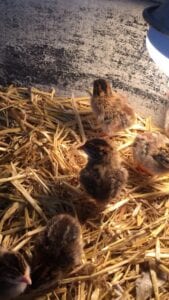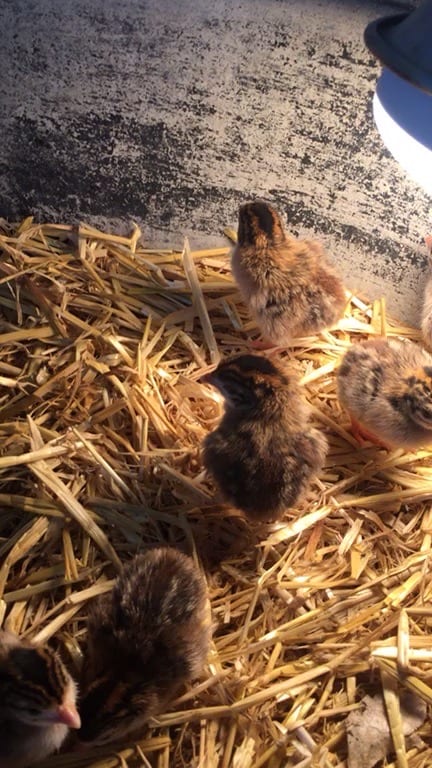
The baby Guinea, Keets.
This year, for the first time since we moved to the Village of Corrales, we found ticks on our dog! When I first saw them, I had no idea what they were. We let the chickens out to free range hoping they’d get rid of the ticks, scorpions, centipedes and other bugs, but the ticks couldn’t be licked!
After some research, we decided we’d raise guinea fowl keets. A neighbor had them years ago and from all that we saw, they make great insect controllers. I don’t like to spray with pesticides, so … we got 6 guinea hen babies.
I’m still new to the process but here’s what I’ve learned so far:
1. Guinea fowl babies, often called guinea keets, aren’t very common at the local mercantile stores. In the past, we raised newly hatched chickens and the local mercantile had baby chicks available for weeks on end. In order to get guinea hen babies, we had to order them ahead. They arrived on time — June 3, 2020 as 3-day old keets. I was amazed at how much they looked like chicks.
2. The guinea foul babies were put into a box and I drove with them on the front seat of my truck. I also picked up some guinea fowl crumbles that were high in protein to help them grow strong. As I drove they chirped loudly. I heard 2 distinct melodies. We’ll see if this actually is true.I’ve read that the male makes the sound of “chi chi chi” and female “come back, come back.” I’ll let you know what I hear as they grow up.
3. When I got the guinea fowl home, I prepared a large horse tank feeder (about 2 feet tall and 5 feet oval) with straw, a container for water and a container for their food. The water container has limited access so the new keets cannot get in, get wet and get cold. For the first week you should give them a heat lamp so they can huddle together under it and stay warm — about 90ºF. As they grow you can raise the lamp and they will adjust to cooler temperatures.
4. I noticed that the baby guinea hens seemed to really appreciate it when I’d put my hand in their tank with food on it. They scurried over my hand and ate enthusiastically. I also poked my finger in their water and the baby guinea hens scurried over to the water and drank. Then when I arched my palm near the edge of their tank, they tried to huddle in my palm. I felt they wanted more security.
5. I have an older chicken that has been broody. What that means is that she has been sitting on the eggs in the chicken coop and doesn’t want to give them up. In years past when she found a secluded area in the barn, I’ve let her sit on the eggs and hatch them which usually takes about 3 weeks. Once the chicks hatched, she’s was a great mother and showed the chicks how to scratch, find bugs and be chickens! I decided to bring this hen into the guinea fowl tank and see what happened. To my delight, she cooed and sang to them and sat down. All the guinea fowl babies scooted underneath her and all was quiet! I was actually concerned the first night because I didn’t hear anything from them. Next morning, all were fine and so was the mother hen. I hear that if you raise guinea fowl with chickens they will get along … let’s see!
6. What I’m noticing is that after 3 days, mother is much more active. Scratching for bugs in the horse tank and when she finds one, her cooing changes, she picks the bug up and drops it over and over until one of the baby guinea hens picks it up and eats it.
7. One concern is that this mother hen scratches enthusiastically, sending the bedding straw and sometimes a guinea hen baby flying. Because of this, I’ve removed the would be chicken-mother and replaced her with a warm shop light.
And here’s a bonus — number 8.
I have prepared a larger area for these guinea keets as they age in the chicken run. When I put them in there, there will be a place they can roost — or sleep comfortably. After 6 weeks, I’ll start letting them out, one-at-a-time. They like to stay together. My hope is they will learn where “home” is because left to their own devices they may decide the entire street is theirs! In time they may find it easier to roost in our tall trees rather than a coop — that’s more their nature. I hope they will also be great guard fowl. We recently lost our rooster to a coyote. From all that I’ve read, they do a great job of sounding the alarm when any animal comes into the yard that shouldn’t be there.
I’m excited for this journey and new learning. I’ll write more as they age. If you have any experience raising guinea fowl, I’d love to hear about it. Please add your comments below.


Wonderful newsletter. Bright and cheerful.
Thanks. We changed the format a little and are enjoying creating the current content. It is fun!
I really enjoyed this story and look forward to hearing more about your Guinea keets.
Yes. They are growing so quickly. They stick close together. I’ll see if I can get some video footage of them. Very cute.